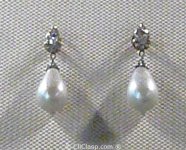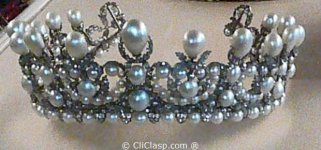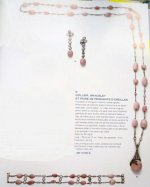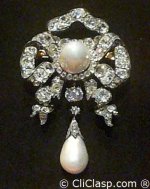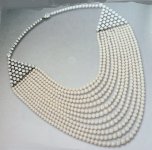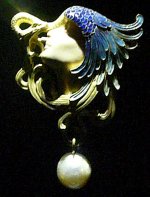C
CLICLASP
Guest
So you said:
...looks to be either enamel, jet or onyx, me thinks enamel though and gold, it looks possibly dated victorian maybe they had a knack for replicating their fanciful Version of stuff...
--
...it looks a little Italian to me--maybe it is the shape of the stations. Not sure the dark material is onyx, but maybe enamel? The whole thing looks weighty...
--
Congratulations ! :
Made of gold, silver, rosecut diamonds , pearls and... black enamel.
French designer Simon Petiteau, jeweler Pierre Caillot, made 1825-1838
composed of necklace, pendant, brooch, earrings.
that's what Cailtin teaches us about this century :
During the 19th century all known sources of pearls were harvested relentlessly by collectors and traders.
By the time photographs of royals and their friends became a popular way to display wealth, the entire European population of lords and ladies was awash with pearls, not just the queen and her direct kin. Maybe it was just for the sake of the photograph to wear all one's pearls at once, but it showed that these pearls are so numerous that some of them must have been acquired over centuries, been well cared for, and passed down from generation to generation, though many may have been recent purchases.
The end of the 19th century was also the end of the ancient pearl trade. There would be few if any more natural pearls as the world had always known them.
to be continued
...looks to be either enamel, jet or onyx, me thinks enamel though and gold, it looks possibly dated victorian maybe they had a knack for replicating their fanciful Version of stuff...
--
...it looks a little Italian to me--maybe it is the shape of the stations. Not sure the dark material is onyx, but maybe enamel? The whole thing looks weighty...
--
Congratulations ! :
Made of gold, silver, rosecut diamonds , pearls and... black enamel.
French designer Simon Petiteau, jeweler Pierre Caillot, made 1825-1838
composed of necklace, pendant, brooch, earrings.
that's what Cailtin teaches us about this century :
During the 19th century all known sources of pearls were harvested relentlessly by collectors and traders.
By the time photographs of royals and their friends became a popular way to display wealth, the entire European population of lords and ladies was awash with pearls, not just the queen and her direct kin. Maybe it was just for the sake of the photograph to wear all one's pearls at once, but it showed that these pearls are so numerous that some of them must have been acquired over centuries, been well cared for, and passed down from generation to generation, though many may have been recent purchases.
The end of the 19th century was also the end of the ancient pearl trade. There would be few if any more natural pearls as the world had always known them.
to be continued

